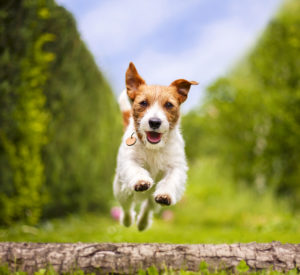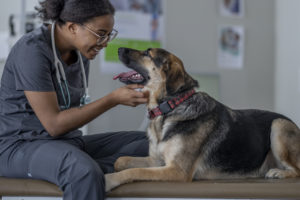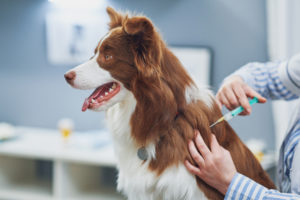Leptospirosis is a dangerous illness that dogs may contract in a variety of ways. It can affect the pup’s liver, kidneys, or other organs.
Leptospirosis is a zoonotic infection that can affect both animals and people. Researchers previously thought that leptospirosis was transmitted mostly in rural areas such as ponds, marshes, and forests. However, veterinarians have seen a recent increase in cases in both suburban and urban areas. The treatment for leptospirosis in canines is antibiotics and supportive care. Treatment varies based on what organs are affected.
If you want to know what leptospirosis is in dogs and how to treat it, check out this informative article.

What is Leptospirosis?
Leptospirosis is an infection that is initiated by Leptospira bacteria. The condition is more common in wet and warm climates or places with high annual rainfall, as it lives in the water. There are three significant forms of this disease:
- Hemorrhagic- There is a high fever and loss of appetite
- Icteric or jaundice – Hemorrhagic symptoms with yellowing of the skin
- Renal- The bacterial infection harms the kidneys and may cause kidney failure
Canine leptospirosis usually affects the liver and kidneys and can become life-threatening. Leptospira bacteria are corkscrew-shaped and can enter through the nose, mouth, or scraped skin. The Leptospira bacteria can trigger liver or kidney failure, an eye disorder called uveitis, and lung hemorrhage.
What Triggers Leptospirosis in Dogs?
Canines can acquire leptospirosis as a result of direct or indirect contact with affected animals such as:
- Deer
- Opossums
- Raccoons
- Rodents
- Skunk
- Squirrels
Direct exposure occurs if your dog encounters an infected animal’s urine, placenta, milk, or semen. Incidental exposure happens when a dog encounters contamination through the soil, food, water, bedding, or foliage. The dog can contract leptospirosis from contact if an infected animal urinates into stagnant water or soil.
Drinking, swimming, or walking in contaminated water can be dangerous for the pup. Leptospira bacteria come in through mucous membranes through the skin, and open sores or broken skin elevates the risk. Leptospira bacteria are typically found in marshy, muddy, or moist areas.
What Type of Dog is More at Risk for Leptospirosis?

Leptospirosis is also most commonly seen during the fall season in marshy or muddy areas where wildlife is prevalent. It may also occur in heavily irrigated pastures. Certain dogs are more at risk for contracting leptospirosis include:
- Dogs that close to the woods or forest
- Dogs that live close to farms or livestock
- Hunting or sporting dogs who spend time outdoors
- Dogs who have been exposed to contaminated soil
Although these dogs are more at risk for leptospirosis, there has been a recent increase in cases in both urban and suburban areas. This means that all dogs, regardless of where they live, are at risk for contracting lepto. Dogs in larger populations, such as shelters, are more susceptible to contracting leptospirosis as well. Canines that have spent time in a kennel may also pose a risk.
What Are Symptoms of Leptospirosis in Canines?
After an incubation period, it can take between 4 to 20 days for symptoms to develop in dogs. The symptoms of the illness will depend on which organs are affected. General symptoms include fever, fatigue, and soreness. Other symptoms include:
- Decreased appetite
- Diarrhea
- Elevated heart rate
- Increased thirst
- Increased urination
- Jaundice
- Trouble breathing
- Vomiting
Common clinical signs for dogs can vary significantly, depending upon the seriousness of the illness and the functionality of the dog’s immune system. Dogs who are infected may also have red eyes and a runny nose.
Some dogs may also have severe muscle or abdominal pain, and female dogs can be infertile due to sickness precipitated by leptospirosis. Dogs may also experience chronic illness, leading to long-term damage to vital organs.
Identifying Leptospirosis in Canines
A vet will evaluate your dog’s medical record and complete a physical assessment. Bloodwork, urinalysis, ultrasounds, or other studies are performed to determine whether leptospirosis is the culprit. If a dog with leptospirosis is hospitalized, they are kept away from other dogs to ensure no further spread of the disease.
Treatment of Leptospirosis in Dogs

If your dog is suffering from acute leptospirosis, you need to get them to the emergency vet immediately, as the condition can be fatal. Dogs with leptospirosis may receive a combination of antimicrobial therapy and supportive care.
The therapy will be contingent on the intricacy of the infection and the symptoms your pup is exhibiting. If the symptoms are severe and enduring, treatment should not be delayed while waiting on confirmation of a diagnosis. Treatment includes:
Antibiotic Therapy
The extended course of treatment for pups with leptospirosis is antibiotic therapy. The preferred choice is typically doxycycline. Penicillin, ampicillin, and amoxicillin may also be effective if given early. Initially, antibiotics should be administered by injection due to vomiting and lack of appetite. After that, antibiotics can be given orally for two to four weeks or until the infection is cleared from the body.
Supportive Care
Every dog is different regarding the level of supportive care they need. The care will vary depending on the extent of the illness and if organs have been impaired. Restoring and maintaining hydration with IV fluid therapy is imperative, as electrolytes must be put back into balance. Antihypertensives, pain control medications, and nutritional support are all critical factors in helping the dog combat the illness.
Leptospirosis Vaccine for Dogs

The leptospirosis vaccine is not typically a part of a pup’s vaccination schedule. However, if your dog frequently goes outdoors, you should consider discussing the leptospirosis vaccine with your veterinarian. Dogs can be offered the vaccine at the stage of eight or nine weeks. Boosters can help build immunity. Immunity to leptospirosis tends to be species-specific.
There can be different species of leptospirosis, and vaccines should correspond with the particular species of the bacteria in your geographic area. If your dog is an avid hunter, goes to dog shows, or spends time at streams or ponds, they should be vaccinated every six months. Otherwise, annual vaccination is recommended.
Be Careful When Handling Dog with Leptospirosis
Leptospirosis is zoonotic, and the contamination could be propagated from animals to people and vice versa. You should avoid contact with your dog’s urine and wear gloves when handling your pup or their things. Wash your hands carefully after touching these objects, and disinfect and clean your home.
Conclusion
Leptospirosis is an insidious disease that can have fatal consequences for your dog if it is not treated in time. If you see any symptoms of this illness in your pup, get them to the emergency vet immediately.
In the Palos Heights, IL area, Palos Animal Hospital is here to care for your pup and answer any questions. Reach out to (708) 448-6600 today!



